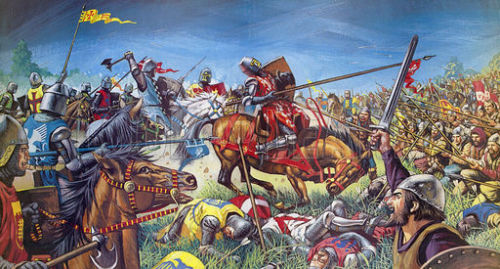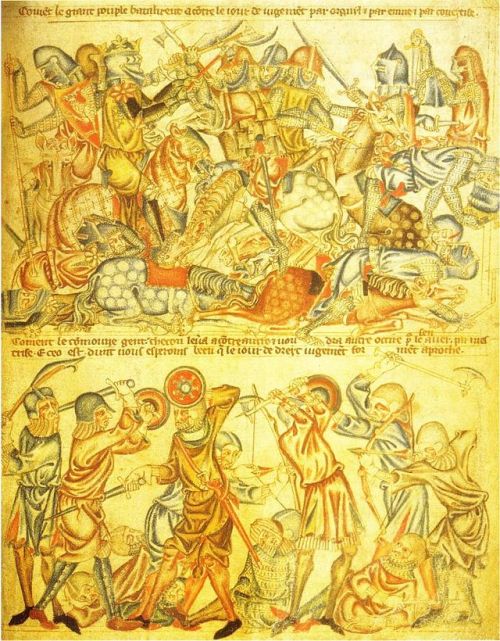peashooter85:Robert the Bruce, The Rebel King Part V — Its Gonna be a Showdown.In case you missed, P
peashooter85:Robert the Bruce, The Rebel King Part V — Its Gonna be a Showdown.In case you missed, Part I, Part II, Part III, Part IVBy 1310, things were looking up for the Bruce. He had destroyed all his Scottish enemies, defeated the English on a number of occasions, and nearly succeeded in unifying Scotland. Over the next four years Robert the Bruce continued his quest by invading the south, and even conducting ambitious raids into Northern England. However the Bruce had not yet truly defeated the English, and his wife and daughter still were held prisoners. If the Bruce didn’t produce an heir anytime soon, all that he worked for over the past eight years would be for nothing. The Bruce knew that he needed to win one big decisive battle to get the leverage he needed for Scottish independence. What he needed was a showdown.In 1314 King Edward II of England personally led a massive army numbering from 13,000 - 25,000 men. Robert the Bruce built his own army, numbering around 5,000 - 10,000 men. As usual, the Bruce placed his army on advantageous ground of his own choosing, in the middle of a large swamp outside of Stirling Castle (held by the English), near a stream called Bannock Burn. There were only a few paths through which men could march through the swamp, and the Bruce ordered trenches dug to block enemy access to all but one; an ancient Roman road leading right to the Bruce’s army. The English made two mistakes which they had consistently made throughout the war. First, they attacked the Bruce on his terms, secondly, they relied too much on heavy cavalry. On the first day of the battle, June 23rd, the English cavalry charged in two columns across the Roman road. Most of the Bruce’s forces were pikemen, armed with long spears and situated in a phalanx formation, a formation dreaded by cavalry. Rather than arrogantly riding down the Scots, the English crashed headlong into the phalanx, becoming impaled and skewered by Scottish pikes. Many other knights and cavalrymen simply became bogged down in the swamp, where Scottish skirmishers would mercilessly dispatch them with warhammers, maces, axes, and knives.In the midst of the fighting, an English knight named Henry de Bohun spotted the Bruce and charged him with his lance. The Bruce met his charge with a battleaxe, but at the last second veered off from the charge, then brutally smashed de Bohun’s skull with his axe. The bout of personal combat between the Bruce and Henry de Bohun turned the Bruce into a superstar among medieval warriors, and a legend among the Scots. Cheers arose from the Scottish army, signaling that indeed the Scots were about to win a grand victory. In the English ranks men began to quiver as one of the best and bravest had been easily dispatched by the Bruce. All the Bruce had to say about the incident was, “I broke my favorite axe.”On the second day of battle, the English sent in their infantry and archers. The narrow Roman road formed a chokepoint which essentially nullified the English’s superior numbers. In fact, more men meant more of a liability as the English army became a chaotic, crowded traffic jam. Men pushed and trampled each other as they tried to advance, while at the same time men tried to retreat lest they be skewered on Scottish pikes. Others drowned in the thick peat and mud of the swamp. Amidst the chaos and confusion, the Scots merely had to sit back and stab the English as they desperately tried to attack the Scottish lines. English and Welsh longbowmen were called to fire upon the Scottish formations, but they were quickly dispatched by a force of Scottish cavalry which flanked and slaughtered the exposed bowman. Eventually the English army regressed into a panicked undisciplined mob. King Edward himself fled the battlefield and escaped on a ship to England. The rest had to flee over 90 miles to the border while being chased by the Scottish army. Out of the 11,000 fleeing English infantry, only 1/3rd would make it safety.It seemed that Robert the Bruce had the decisive victory that he needed. His one-on-one bout of combat against Henry de Bohun made him a legend of medieval warfare and the victory forced all remaining English forces to leave the country. The Battle of Bannockburn would go down in history as one of the greatest Scottish victories, and cement Robert the Bruce’s title as King of Scots. Most importantly, the Bruce captured enough English knights and noblemen for ransom that he was able to win back his wife and daughter, as well as a number of other important supporters. Now that the king had his beloved queen, it was time for the Bruce to settle down to the business of making an heir and building a dynasty.Unfortunately, the story doesn’t end here, for King Edward II had one more ace up his sleeve. A power different from knights and armies which threatened to completely undermine the Bruce and Scotland forever. The power of God and religion.To be Continued… -- source link


